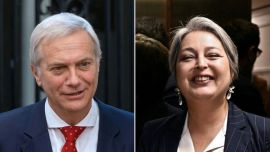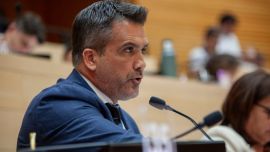The International Monetary Fund on Friday approved its 23rd loan agreement with Argentina, a serial defaulter.
The new loan for US$20 billion comes on top of an amount of some US$44 billion Latin America's third-biggest economy already owes the lender, with which it has a long and complicated history.
Argentina, which has a track record of economic crises and hyperinflation, is already the IMF's biggest debtor, ahead even of war-torn Ukraine.
Here is a short history:
The beginning
Argentina joined the IMF in September 1956, and received its first loan from the global lender just over two years later as it sought to stabilise a flailing economy and fight spiralling inflation.
Three more loans followed in as many years as the desired results were not achieved.
Over the decades to follow, the IMF would come to Argentina's aid repeatedly with bailouts in different forms, benefiting governments on both the left and right of the political spectrum – even the country's military dictatorship in charge from 1976-1983.
The shadow
In 2001, Argentina was in the grips of a severe economic crisis, partly due to extensive borrowing, and defaulted on its repayment obligations – the biggest such failure in IMF history.
Buenos Aires eventually cut ties with the global lender in a crisis that toppled the government of president Fernando de la Rúa.
The government fell partly over so-called "corralito" measures it imposed to limit capital flight – seen as draconian and the catalyst for protests that left 39 people dead.
The events left a bad taste in the mouths of many Argentines, and according to a recent poll 55 percent hold a "bad" or "very bad" image of the lender.
IMF loan conditions "always involve an adjustment, which mainly impacts the middle class, the poor, and national industries," said Noemi Brenta, author of a book on Argentina's debt history.
"Every time something is approved with the IMF, things get worse for us," Rodolfo Celayeta, a 73-year-old retiree, agreed at a recent anti-austerity protest.
The return
In 2006, under leftist president Néstor Kirchner, Argentina paid off IMF debts that amounted to some US$9.8 billion at the time.
For 12 years, no new loans were granted.
The record
Then, in 2018, the government of cetnre-right president Mauricio Macri acquired a new loan for a record amount of US$57 billion.
Only US$44 billion was disbursed after Macri's successor, Alberto Fernández, refused to accept the rest and sought to renegotiate repayment terms.
The 2018 agreement was meant to stabilise Argentina's economy, but failed as a sharp devaluation of the peso, runaway inflation and recession left the country with overwhelming debt.
In December 2021, the IMF conceded the loan had failed to achieve its objectives of restoring confidence in the country's fiscal viability and fostering economic growth.
In 2022, an Extended Fund Facility (EFF) agreement was reached to refinance Argentina's previous commitment.
The latest
Since taking office in December 2023, budget-slashing President Javier Milei has sought a new loan under the existing EFF programme that he says will be used to cancel debt to the Central Bank, wipe out stubborn inflation, boost growth and replenish foreign reserves.
Milei's austerity measures have reduced inflation and resulted in Argentina's first budget surplus in over a decade, but also tipped the country into recession and millions more people into poverty in the first months of his government – though official data shows the numbers improving.
The IMF has praised Milei's efforts, and has projected growth for the Argentine economy of five percent for 2025 and 2026 – more than the global average.
Economist Martín Kalos of the EPyCA consultancy firm, said Argentina has so far repaid little more than the interest on its 2018 loan, and still owed about US$40 billion – to which another US$20 billion will now be added.
Argentina, he told AFP, "has many years ahead during which it will continuously have to renegotiate with the IMF."
related news
by Philippe Bernes-Lasserre, AFP



















Comments